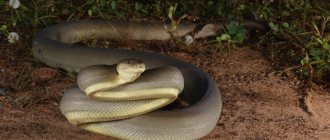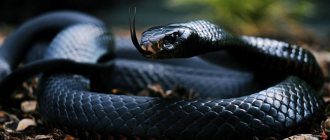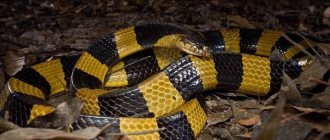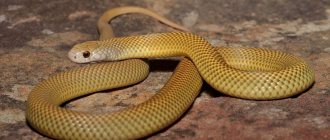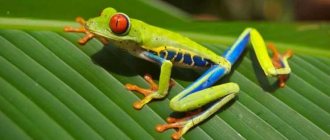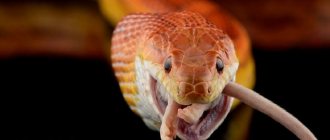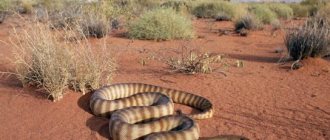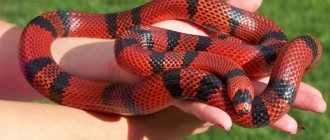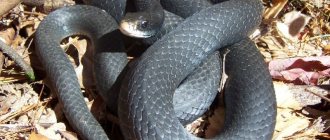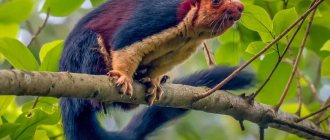Gyurza
This representative of giant vipers does not have the most impressive dimensions. It can grow up to 2 meters in length, and its weight does not exceed 3 kg. But this does not prevent her from being one of the most dangerous to humans. Gyurza has a lightning-fast reaction and an incredible ability to rush at his target, covering a distance of 2 meters in one jump. Even experienced snake catchers sometimes cannot cope with this poisonous beast, since it is quite difficult to hold its muscular body in your hands.
The distribution area of the viper is extensive; it can be found in the countries of the former Soviet Union, in many Asian countries, on the African continent and some other places.
Enemies of large species of snakes
Natural enemies of snakes can be not only mammals and birds, but their relatives.
One of these enemies is the hedgehog, which is resistant to snake venom and, thanks to this feature, hunts and eats vipers. Snakes are also hunted by mammals such as foxes, martens, ferrets and weasels. The mongoose is considered one of the most dangerous snake enemies.
In addition to mammals, many birds hunt snakes. Eagles, hawks, storks and even crows are enemies of snakes.
Lachesis, a Brazilian rattlesnake, is also not averse to feasting on other snakes, as are adders, coral snakes.
Black Mamba
The African inhabitant of savannahs and woodlands cannot boast of a very large size. Its length on average does not exceed 3 meters, its weight is usually about one and a half kilograms. There are larger specimens, but they are extremely rare.
Despite its relatively modest size, this aggressive snake inspires fear among local residents, as it is one of the most poisonous on the planet. In addition, it is distinguished by its ability to develop a speed that is phenomenal for a snake - more than 11 km/h. The bite of a black mamba is fatal to humans. Death can occur in less than an hour.
How do they hunt and kill, are anacondas poisonous?
They tightly wrap themselves around their prey, that is, like all non-venomous snakes (pythons, boa constrictors and others). These representatives of reptiles kill their food by suffocating it. Anacondas, most often firmly holding the head of the victim with their jaws, braid their powerful bodies around the carcass of the caught animal and press, intensively squeezing the flesh until the victim suffocates and dies.
Other methods of murder
When the snake is still young, its hunting technique is slightly different. Indeed, given that it is less heavy, it positions itself on a tree branch and falls onto its prey as it passes under it. At an older age, a real anaconda only lifts its head out of the water and waits patiently for its prey to come up and start drinking. Possessing sharp teeth, it first sinks its fangs into its prey and then immobilizes it by wrapping its body around it. Finally, he lowers him to the bottom of the water to drown him.
It feeds mainly on rodents and birds, which it watches at night. But it can also swallow larger animals such as a dog, goat or even another snake.
Surukuku
Another name for this poisonous snake is bushmaster. It lives mainly in the tropical forests of South and Central America. Surukuku grows no more than 4 meters in length, weight can vary from 3 to 5 kg. This snake is distinguished by a timid character and a love of solitude, which is why human encounters with it occur infrequently. There have been only 25 recorded cases of surukuku attacks on people, 5 of which resulted in death. Its usual menu consists of rodents, birds, and lizards. The bushmaster will not disdain another snake. Thanks to its enviable endurance, the surukuku can lie in ambush for several weeks while waiting for suitable prey.
Appearance of the largest species of snakes
The snake has an elongated, limbless body whose length can range from 10 centimeters to seven meters. A distinctive feature of the reptile is the movable connection of the parts of the jaws, which allows the snake to swallow the victim whole.
The snake's body is covered with scales. During molting, the skin changes entirely, in a single layer. The snake's eyes, due to the specific structure of the eyelids, covered with hard scales, are always open.
Shedding is not only necessary to replace worn-out skin cells, but also helps snakes get rid of parasites. It occurs at certain intervals throughout life. The inside of the snake's old skin liquefies, causing it to separate from the new skin.
After several days, the snake sheds its old skin. Adult snakes are capable of shedding their old skin several times a year. In contrast, young animals can shed their skin up to four times a year, due to their growth.
Another distinctive feature of snakes is that in many species of reptile the skull bones are movable relative to each other.
In combination with the elastic ligament of parts of the jaws, this feature allows the reptile to swallow very large prey whole. There are cases where large snakes swallowed a sleeping person whole.
King Cobra
She is also a hamadryad. Being the largest among all venomous snakes, the king cobra is inferior in the strength of its venom to many other representatives of the snake world. The longest individual, more than 5.5 meters, lived in the London Zoo, where it was brought from Malaysia. The average length of king cobras is usually within 3-4 meters. The weight of an adult can reach 6 kg, and particularly large individuals can weigh up to 12 kg. Hamadryads live in the south and southeast of Asia, choosing wooded areas. They often creep up to residential buildings. The king cobra hunts during the day. It is noteworthy that it feeds on its own kind, without making concessions even to its poisonous relatives.
Diet of large breeds of snakes
All snakes studied so far are predators and feed on a variety of animals, the size of which depends on the type of snake. Snakes can also eat bird eggs.
Snakes that do not have a poisonous bite strangle their victims with their jaws or powerful bodies, wrapping them in rings. Poisonous individuals kill their prey with poison introduced into the victim’s body by a bite with poison-conducting teeth.
The process of eating occurs by swallowing the prey whole. This process occurs due to alternating jaws.
Common boa constrictor
This non-poisonous representative of the pseudopod family grows no more than 4.5 meters in length. Its maximum weight is 15 kg. It prefers to settle closer to bodies of water, but some subspecies have also adapted to life in arid areas. The homeland of ordinary boas is considered to be Central and South America, as well as the Lesser Antilles. Due to the great popularity of these reptiles among exotic pet lovers, Florida has become their second home. Some careless breeders simply released massive pets into the wild, where they successfully took root and began to reproduce.
Common boas hunt mainly on the ground; only light specimens set up ambushes in trees. Their favorite food is possums, birds, rodents and other reptiles.
Reproduction of the heaviest snake
Single anacondas. They try to gather in groups only during the breeding season, which occurs in the middle of spring. It is at this time that the rainy season begins in the Amazon basin - a very favorable time for the water snake.
During the breeding season, females crawl out of the waters, leaving a special smell of pheromones on the ground. The males find them by this smell.
Anacondas are ovoviviparous reptiles. From the mating season until the birth of offspring, 6-7 months pass. It is typical that during this time the females become very exhausted. Many lose almost half of their weight. Eggs are laid extremely rarely in females at the end of the incubation period. In most cases, the shells of the eggs burst while still in the womb, and baby snakes are born. One female is capable of giving birth to 28 to 45 cubs. Although, some sources describe cases when females gave birth to 100 small snakes.
Amethyst Python
This species is common in Australia, where it is protected at the legislative level. Some subspecies settled on nearby islands. Being the largest on its continent, the amethyst python grows no more than 6 meters. The average size of individuals is 4 meters. The maximum weight of a python can reach 30 kg. Like all members of its family, the amethyst python is non-venomous. Leads a predominantly semi-arboreal lifestyle and can be found close to city limits.
Found even in the city: reticulated brown snake
Habitat: Australia, New Guinea, Indonesia.
In the list of the most dangerous land reptiles, the reticulated brown snake is second only to the taipan. But if the latter prefers to settle away from people, this reptile can be found near farms and even in urban areas. The reason is a diet consisting mainly of rodents.
Wherever the reptile goes in search of food! And since it hunts during the day, it accounts for the majority of snakebite victims in Australia. She is not the first to attack, but if disturbed, she will use her weapon.
Tiger python
This snake is distinguished by its impressive size, while possessing a calm disposition, for which it has gained fame in many circuses and zoos around the world. The length of the tiger python can reach 5.5 meters and weigh more than 50 kg. Representatives of this species live in South and Southeast Asia, without making any special demands on the area around them. They feel equally good in tropical forests and at the foot of mountain ranges. They are excellent swimmers and excellent tree climbers, but for the most part lead an inactive, sedentary lifestyle.
By the way, it was this representative of the snake kingdom who became one of the main characters in the famous “The Jungle Book” by R. Kipling. Although in some cartoons Kaa is depicted as a boa constrictor.
3. Burmese python or dark tiger Length 5.8 m
Among pythons with a color like a tiger, this species will be the largest. It lives in Asian countries such as China, Thailand, Indonesia, Vietnam, and also in India. The record length of the Burmese python was 8-9 m with a weight of 70 kg, but specimens with a length of up to 5.8 m are most often found. Such dimensions allow us to place the tiger python in third place in the ranking of the longest snakes in the world. Pythons love swampy areas and tropical rainforests. They are excellent swimmers, and light-weight young individuals can nimbly climb trees. A calm python, sitting in a secluded place, can determine the location of prey using thermolocators, capturing thermal radiation and smell. It eats birds, rodents, monkeys, but can attack a pig or goat. These snakes are often kept as pets, although this is an expensive hobby.
Among tiger pythons there are albinos, which have a very beautiful yellow-white color.
Hieroglyphic python
It is also called rock python. The length of the largest representatives of this species exceeds 6 meters, and the weight can approach 100 kg. Medium-sized individuals usually grow up to 4.5 meters, their weight is about 45-55kg. Hieroglyphic pythons are common on the African continent and can be found in tropical jungles and savannas. In terms of food preferences, this type of python is not particularly different from other members of the family. Their snacks include rodents, birds and reptiles. A large rock python can easily eat a plump warthog and even a small alligator.
2.Reticulated Python Length 7.5m
The reptile lives in Southeast Asia and in some sources the reticulated python is called the longest snake in the world. This is not entirely true; it is reliably known that the largest representative of this species was 7.5 m in length. The python's name was Samantha, and he lived in the Bronx Zoo (New York). The snake died in 2002. It is also worth considering that the python loses to the anaconda in weight. This type of snake got its name from its black pattern, similar to a fishing net. The color is dominated by brown, yellow and gray colors, which helps the snake camouflage itself as tree bark or fallen leaves. The reticulated python likes to live near water, in grassy areas. It can often be seen in hayfields, where it poses a serious danger even to cattle. These snakes hunt rodents, monkeys, birds, but when possible they attack goats and pigs. Like all pythons, this species is not poisonous. Now these reptiles are protected by law, as they could completely disappear due to their capture by humans for their valuable skin and meat. The ban on the destruction of the reticulated python plays a huge role in restoring the population of this unique species.
Anaconda
It is called green, giant or common anaconda. And for her love of spending most of her time in various bodies of water, she was given another name - water boa.
Anacondas live in the tropics of South America. There are many rumors associated with this snake; its size is often greatly exaggerated. The largest specimen measured reached just over 5 meters in length and weighed 97.5 kg. Despite the fact that the average length of the anaconda is only 4.5 meters, it is considered the heaviest snake in the world. Indeed, with such a relatively modest length, the weight of this reptile can exceed 60-70 kg. The water boa hunts mainly on birds, mammals and other reptiles that come to a watering hole or accidentally find themselves near the water. There is a known case when an anaconda was able to dine on a 2.5 meter long python.
7.Black mamba Length 4.5 m
This reptile can boast sizes of up to 4.3-4.5 m, although its usual size is 2.5-3.5 m. The snake is noticeable because in Africa, where it is found, it is considered the most poisonous. Also, the Black Mamba is one of the fastest snakes in the world. In pursuit of a victim, at a short distance, it is capable of moving at speeds of over 11 km/h. Cases have been recorded when the snake reached speeds of 18-19 km per hour. Mamba has a reputation as a merciless killer. Its venom is very toxic. Death from a bite by this snake can occur within 45 minutes. It was named so due to its gaping mouth, reminiscent of a coffin, the internal cavity of which is black, like the whole snake. Young specimens have a lighter tone, but “with age” the specimens turn black. The species is not only found in Africa; the snake loves continental climates and thrives in deserts, woodlands or mountains.
Common blind snake, 38 cm
In another way it is called worm-shaped blind snake . This is a small snake, the length of which, including the tail, does not exceed 38 cm. It is very similar to an earthworm, with an incredibly short tail. Color – brownish or slightly red.
The common blind snake molts directly in the soil. Found in Dagestan, Asia Minor, Syria, the Balkan Peninsula, etc. It chooses dry and gentle slopes and thickets of bushes. Its burrows are narrow, reminiscent of worm passages, and can occupy ant nests.
Tries to hide under rocks. If you move them away, the snake goes into the ground faster. In the spring it wakes up from hibernation in March-April and hides in the ground on the driest and hottest summer days.
Pygmy African viper, 25 cm
It is classified as a genus of African vipers and is poisonous. It is small in size: from 20 to 25 cm, maximum length is 32 cm. The longest and heaviest are females. They are distinguished by a thick body of gray or reddish-yellow color with small dark spots.
The African pygmy viper lives in the sandy deserts of Angola and Nambia, i.e. in the Namib Desert and regions adjacent to it. If he sees danger approaching, he hides in the sand. During the day it lies down in the shade of bushes, buried in the sand. Shows activity at dusk and at night.
Eats small lizards, geckos, and invertebrates. If it bites a person, there will be pain and swelling, but its venom cannot be called deadly, because. she administers it in small doses. Lizards die from it only 10-20 minutes after the bite.
Barbados narrowmouth snake, 10 cm
Lives only on the island of Barbados. In 2008, the Barbados narrowmouth was found by US biologist Blair Hedge. Lifting one stone, he found several snakes, the largest of which was 10 cm 4 mm.
In appearance, snakes look like earthworms. They spend most of their lives hiding under stones or in burrows in the ground that they create themselves. It feeds on ants, termites and their larvae. She secretes a special secret that helps her penetrate their nests and eat the larvae.
A newborn snake is even smaller than its mother, i.e. about 5 cm. Often one individual produces only 1 cub. They are called short-mouthed because they have a special mouth structure: there are no teeth at all in the upper jaw, they are all on the lower jaw.
0 0
Japanese snake, 50 cm
Lives in China, Japan, Korea, Russia. It chooses to live in broad-leaved or mixed forests, thickets of shrubs, such as raspberries and rose hips.
It is not so easy to see her, because... The Japanese snake is a secretive snake, most of the time it hides underground, hiding under stones, trees, and stumps. It is tiny, up to 50 cm, brown in color, sometimes lighter brown, the belly is greenish.
Eats shellfish, earthworms and small frogs. Young snakes are from 11.5 cm in size; they are considered adults when they grow to 32-36 cm.
Tame eirenis, 60 cm
Belongs to the family of colubrids. Adults do not grow more than 60 cm. They are beige, brown or gray in color. The heads are usually dark and have a spot behind the eyes that resembles an "M", but this head color changes over time.
The humble Eirenis lives on many islands in the Mediterranean and also the Aegean Sea; it can be found in open areas in the steppe or rocky slopes, where there are many plants. During the day he camouflages himself in their thickets, and in the evening he crawls out of his hiding place. Feeds on insects. It spends the winter in hibernation; from November to April it will not be possible to see it.
Brahmin blind, 15 cm
A small snake, 10 to 15 cm long, colored brown and black. When you look at it, it looks like a small trickle of oil is flowing. Sometimes it is gray or reddish brown in color.
The Brahman blind snake is also called a pot snake , because. it can live in flower pots. It is found naturally on the islands of the Indian and Pacific Oceans and in southern Asia. It spread over a large area thanks to people who transported it along with potted plants.
It lives in the ground or hides under rocks, eating insects and worms. They are called blind snakes for a reason, but because due to their existence underground, the vision of these snakes has atrophied and they can only distinguish where it is light and where it is dark.
Arizona adder, 40 cm
Belongs to the family of asps . He has an incredibly thin body with a small head. The body is all striped red, yellow and black. Lives in the deserts of the southwestern United States and Mexico.
It feeds on insects, lizards, and small amphibians. If the snake sees that it is in danger, it begins to draw air into its lungs and exhale it rhythmically. At the same time, a series of popping sounds appear.
Common copperhead, 70 cm
The body length of this snake is about 60-70 cm; males are smaller in size than females. The common copperhead lives in Europe. Chooses clearings, sunny edges, meadows for life, avoiding places with high dampness. But if necessary, these snakes swim well.
The peak of activity for this snake is in the morning and evening; it prefers to appear during the day, but occasionally comes out of its hiding place in the dark. It hides in rodent burrows, in voids that form under stones and rock cracks.
The copperhead hunts lizards and sometimes eats mice, chicks and various small vertebrates. The prey is first compressed by the rings of its body. It is active for about six months and goes into hibernation in September or October. The snake becomes sexually mature at 3-5 years old, when its length reaches 38-48 cm. It lives for about 12 years.
